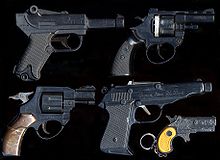Toy gun
Under toy weapons one understands real commonly imitations weapons . In the children's game, however, in principle any object can also become a play weapon. It does not depend on the real object, such as a stick, a pine cone or a travel knife, but on the symbolic assignment of meaning to the object by the players and on the action.
Weapon types
The following weapons are widely used as traditional toys:
- Arch weapons : arrow and bow , crossbow
- Firearms : pistol , rifle , slingshot
- Throwing weapons : spear , boomerang , lasso , throwing ax , throwing knives
- Cutting and stabbing weapons : knife , sword
Children use simple sticks as a “sword”, “dagger” or “spear” or a curved branch as a “pistol”. They build their own bow from hazelnut sticks and a string, carve elaborately decorated pointed and sharp swords, daggers and spears. Slingshots and boomerangs are also built and carved by themselves.
Adults also use toy weapons; for example in Indian, Western or medieval clubs or simply as a collector of replicas .
The toy industry has a very large variety of toy weapons on offer, from simplified and scaled-down plastic replicas to true-to-original replicas and fully functional weapons. In various countries there are legal regulations according to which the toys are to be identified as such, for example by means of signal colors.
Many pistols and rifles appear even more realistic because of the shooting noise. There are relatively harmless ammunition for toy weapons. These ignition platelets are available in various designs and sizes. Water pistols and soft guns (" pea pistols ") up to a shot energy of 0.08 joules are free for children aged three and over. Airsoft guns are available from the age of 14 with a projectile energy of less than 0.5 joules.
Since the advent of the media age, conventional physical toys have been increasingly replaced by virtual toy weapons, which are already popular in preschool age.
Historical view
For centuries, boys have been introduced to the use of weapons and the learning of fighting skills in a playful way. Especially in times of war and preparation for war, war toys regularly gain importance in the commodity trade and in the population. Military tin, lead and pewter toys can be traced back to the early 19th century using product catalogs. What little man doesn't want to be a big man? The age-old passion of imitation only finds complete fulfillment in children. The boy with a helmet, drum, trumpet, saber and rifle really thinks he is a real soldier ... writes Bernhard Kroner in a treatise on the history of war toys. Boys' toys contain ideals of masculinity that the playing boys emulate and experience. They are ... influenced in the development of their gender identity . In an appeal by the toy industry in 1933, every German boy must be given lead soldiers again for Christmas to maintain the German defense concept . Scenarios such as “cowboys and Indians”, “ robbers and gendarmes ”, “knights”, “dragon slayers” are used as well as “fighting against hostile groups” or “self-defense”.
Since the peace movement of the 1970s, the meaning of such games has been questioned again and again. The discussion regularly comes back to life , especially after reports about young shooters at amok . The arguments are mostly based on unproven transfer assumptions on the attitudes and behavior of children and adolescents, which, however, can neither be scientifically nor statistically proven for the war games or for the peace games created as a contrast at the time . However, to this day, the educational efforts of the game enthusiasts have had almost no influence on the fascination of playing war and the enthusiasm for appropriate weapons that suggest strength, power and influence and promise a high level of tension. With the growth of the media worlds, the interest of the players has only shifted more from the physical to the virtual play areas.
Legal regulations
Toy guns are not generally prohibited. Such a legal measure would fail due to the impossibility of defining what is to be understood by toy weapons. Nevertheless, restrictive regulations apply in various countries:
With the tightening of the Weapons Act in 2008, toy pistols were classified as so-called fake weapons in Germany if certain criteria were met . This means that it is forbidden to carry “weapons” openly, which at first glance cannot be distinguished from real weapons. This also includes carrying any airsoft weapons. This is regulated by § 42a (WaffG). A similar legal regulation applies z. B. also in Switzerland. The background to this is the risk that - as has happened repeatedly - confusion and critical situations can arise if police officers cannot determine whether an operation against an alleged perpetrator is a toy gun or a real firearm.
Pedagogical aspects
The ambitious discussions on the subject of “war toys” do not make it easy for parents and educators to filter the rational core out of the often prejudiced opinions and personal fears and to find an appropriate pedagogical approach for their own educational measures. War toys are presented in a great variety and range, which makes it difficult for the uninitiated to see.
Play educators advise parents and educators above all to be calm, but also to watch carefully if the offspring tends to play war toys in order to be able to participate in the exciting game and not be excluded from playing with their peers. An indispensable prerequisite for this is an unprejudiced, rational approach to the nature and meaning of play on the basis of the findings of game science . Of elementary importance is the ability to differentiate between the reality level of war, on which damage, injury and killing is consciously sought, from the symbol level of the game, which is designed for joyful, injury-free, strict rules-based action. This discernment must be learned from adults and imparted to adolescents.
See also
literature
- Barbara Sichtermann: ... because it doesn't hurt anyone. The symbolism of the war game. In: The time . October 25, 1991, p. 106.
- Galerie Siebzig (Ed.): War toys, are they still toys? , Frölich and Kaufmann, Berlin 1982, ISBN 3-88725-130-X . Previously published under the title: Henning Erbs u. a .: Is that still a toy? Edition Galerie 70, Berlin 1979.
- Siegbert A. Warwitz, Anita Rudolf: War and peace games . In: The sense of playing. Reflections and ideas for games , 4th edition, Schneider, Baltmannsweiler 2016, ISBN 978-3-8340-1664-5 , pp. 126–151.
- Gisela Wegener-Spöhring: The meaning of "war toys" in the world of elementary school children . In: Zeitschrift für Pädagogik , No. 6/1986, pp. 797–810.
- Gisela Wegener-Spöhring: War toys and computer games in the world of elementary school children: a crisis of “balanced aggressiveness”? In: Titus Guldimann: Education 4- to 8-year-old children , Waxmann, Münster 2005, pp. 169–188, ISBN 3-8309-1533-0 .
Individual evidence
- ^ Reporting year 2004 , Oldenbourg Verlag, page 115
- ↑ Bernhard Kroner: Brief history of the political functions of war toys in Germany, in: War toys. Is that still a toy? Berlin, 2nd edition 1982, pages 38-66
- ↑ Susan Dörfler: Toy weapons in kindergarten - A critical inventory of opinions and theories , GRIN Verlag, 2006, p. 26
- ↑ Das Neue Tage-Buch, Volume 1 Verlag Nederlandscher Uitgeverij, 1933
- ^ Siegbert A. Warwitz, Anita Rudolf: War and Peace Games . In: The sense of playing. Reflections and game ideas . 4th edition, Schneider, Baltmannsweiler 2016, pp. 126–151
- ↑ http://www.tagesspiegel.de/politik/deutschland/Waffenrecht-Anscheinswaffen;art122,2480913
- ^ Siegbert A. Warwitz, Anita Rudolf: The assessment of the war game . In: The sense of playing. Reflections and ideas for games , 4th edition, Schneider, Baltmannsweiler 2016, pp. 131–135
- ↑ Toy guns are less bad than their reputation - in "Neue Zürcher Zeitung" February 23, 2015
- ↑ Barbara Sichtermann: ... because it doesn't hurt anyone. The symbolism of the war game. In: The time . October 25, 1991, p. 106


